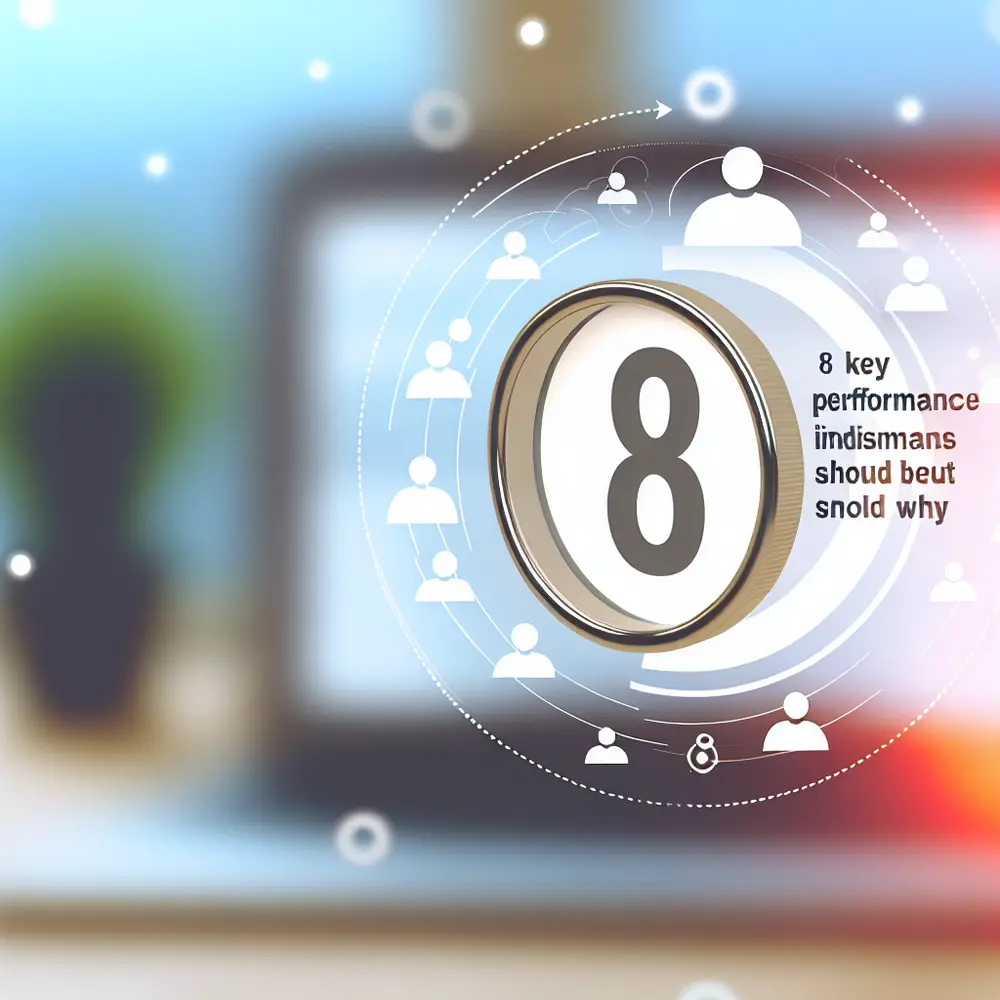As a business owner or manager, you face the challenge of navigating the complexities of performance evaluation. Identifying what truly drives success within your organization can be daunting. This is where understanding Key Performance Indicators (KPIs) comes into play.
You need a clear, actionable strategy to measure progress and make informed decisions. Without the right metrics, you risk misalignment with your business goals, leading to missed opportunities and inefficiencies. This article dives into the significance of KPIs and how mastering them can propel your organization to new heights.
Whether you are aiming to enhance sales, improve customer satisfaction, or boost operational efficiency, KPIs provide a framework that translates your strategic objectives into quantifiable figures. Let’s explore how setting and measuring the right KPIs can drive your business forward.
Understanding KPIs: What Are Key Performance Indicators?
Key Performance Indicators (KPIs) are measurable values that demonstrate how effectively you achieve your strategic objectives. By using KPIs, you can gauge performance across different areas and ensure that your organization remains on track to meet its goals.
Establishing clear KPIs is essential for effective goal setting. They translate broad objectives into quantifiable figures that you can monitor regularly. Imagine a company, the Transportadora Cedro, striving to increase sales. They set KPIs such as a 15% growth in revenue and a target of acquiring 50 new customers monthly. This structured approach allows them to assess their sales strategies efficiently.
KPIs are also crucial in identifying trends and patterns within your data. Analyzing performance metrics over time gives insights into where you excel and where improvements are needed. For instance, tracking customer satisfaction scores can reveal strengths in product quality and service efficiency, guiding your strategic decisions.
Relevant KPIs aligned with your organization’s objectives are vital. They must be actionable and allow for regular performance assessment. The Clínica Santé, for example, integrates patient feedback into their KPIs, addressing both employee engagement and service productivity. This holistic evaluation ensures they focus on all business aspects.
The process of using KPIs goes beyond measurement; it embodies a continuous cycle of improvement. Regular reviews ensure that your indicators remain relevant. The Loja Natureza linked their KPIs to broader marketing strategies. This proactive approach led to a 25% increase in profitability over one year.
The Importance of Measuring KPIs for Business Success
Measuring KPIs is essential for business success, providing concrete data on performance metrics to inform your strategic decisions. In a data-driven world, the ability to analyze these metrics critically sets successful companies apart.
Effective goal setting relies on establishing relevant KPIs. For instance, if your goal is to enhance customer satisfaction, implementing KPIs related to customer feedback ensures that all efforts contribute towards achieving broader business goals. The Transportes Avante launched a feedback initiative that improved customer satisfaction by 30% within three months.
Business analytics is crucial for uncovering the story behind numbers. With KPIs, you can explore patterns that reveal strengths and weaknesses. This analytical approach often results in enhanced operational efficiency, as seen with the Fábrica Ecológica, which improved productivity by 20% after analyzing their manufacturing KPIs.
Benchmarking KPIs against industry standards also clarifies your performance stance. Understanding where you stand against competitors helps drive innovation. For example, a clothing retailer, Moda Verde, regularly compares their sales conversion rate with industry averages to identify areas needing attention. You can see notable results by looking into Best Customer Service Platforms.
The use of KPIs is not static; it requires continuous adjustment. Regularly reviewing your KPIs allows adaptation to market conditions. By fostering a culture that values ongoing assessment, companies can maintain agility.
Top 8 KPIs Every Business Should Measure
KPIs are essential metrics providing insights into your business performance. By effectively measuring these indicators, you can make informed decisions driving growth. Here are the top eight KPIs every business should prioritize.
1. Revenue Growth Rate
The revenue growth rate assesses how quickly your company is expanding. Monitoring this KPI enables an evaluation of strategies, helping identify opportunities for improvement. The Agência WebPlus saw a 22% increase in revenue by tracking this crucial metric monthly.
2. Customer Acquisition Cost (CAC)
CAC quantifies the cost associated with acquiring a new customer. Analyzing this KPI helps optimize your marketing budget. When Consultoria Inova reduced their CAC by 15%, they significantly enhanced their spending efficiency.
3. Customer Lifetime Value (CLV)
CLV measures the total revenue expected from a single customer throughout their relationship. This metric allows you to focus on enhancing customer relationships, which is vital. When the Restaurante Sabor do Mundo improved CLV by 25%, it bolstered their long-term profitability goals.
4. Net Promoter Score (NPS)
NPS gauges customer satisfaction and loyalty. Tracking this KPI helps identify areas for improvement, ultimately benefiting retention rates. After implementing an NPS survey, the Loja Digital increased loyalty by 30% through targeted enhancements.
5. Churn Rate
The churn rate indicates the percentage of customers who stop doing business with you. A high churn rate signals dissatisfaction. The Assinaturas Rápidas investigated their churn and improved customer retention by 40% after implementing feedback mechanisms.
6. Sales Conversion Rate
This KPI measures the percentage of leads that result in actual sales. By analyzing this, businesses can optimize sales strategies. The Imobiliária Excelência increased their conversion rate by 18% through refined sales techniques.
7. Employee Engagement Score
Engagement is critical for success. This KPI measures workforce commitment satisfaction. When Escritório Criativo Prazer assessed their employee engagement, they recorded a 15% increase in productivity.
8. Operational Efficiency Ratio
This ratio assesses how effectively you utilize resources to generate revenue. By analyzing this metric, organizations can identify inefficiencies. The Fábrica Rápida optimized their operations, achieving a 25% efficiency boost.
How to Set SMART Goals Using KPIs
Setting SMART goals is crucial for leveraging KPIs effectively. SMART stands for Specific, Measurable, Achievable, Relevant, and Time-bound, ensuring alignment with your business objectives.
Specificity is key. Clearly define what you want to achieve. For example, instead of “improve sales,” specify “increase sales by 20% in the next quarter.” This approach enhances focus. The Agência Foco utilized this method, achieving a 30% sales uptick.
Measurable metrics are vital. Establish how each KPI will be measured. For instance, implementing NPS for customer satisfaction allows clear tracking over time.
Set achievable goals that consider your capabilities. The Loja Ecológica engaged in realistic goal setting that led to a 25% increase in customer retention.
Ensure relevance as goals must tie to your strategic priorities. If improving customer service is your focus, implement KPIs like response time.
Finally, make goals time-bound. Set deadlines for achieving your KPIs. The Construtora Moderna employed quarterly reviews, enabling timely adjustments based on performance data.
Tools and Techniques for Tracking Performance Metrics
Effective tracking of KPIs is crucial for achieving your goals. Utilizing the right tools enhances your ability to analyze performance. Various software solutions provide in-depth insights into KPIs.
Business analytics tools compile and visualize metrics. Customizable dashboards enable you to prioritize relevant KPIs. The Startups Digitais optimized their performance evaluation by using such platforms, focusing on what truly drives their growth.
Goal setting is integral to tracking KPIs. Clarity in objectives ensures alignment with business strategies. By embedding SMART goals into the performance tracking process, you can maintain consistent monitoring against defined metrics.
Incorporating automation into your tracking can enhance efficiency. Many business intel tools automate data collection and reporting. This reduces human error and streamlines decision-making processes, evidenced by Logística Expressa, which improved accuracy by 30% through automation.
Finally, establish a culture valuing data-driven decision-making. Regular metric reviews foster accountability. The Agência de Inovação fostered such a culture and saw engagement improvements leading to better overall performance.
Interpreting KPI Data: Turning Metrics into Actionable Insights
Effective interpretation of KPIs is crucial for enhancing performance. Analyzing KPI data begins with identifying trends over time. For instance, tracking sales growth rates helps align marketing strategies with goals.
Segmenting performance metrics offers deeper insights. Breaking down data by demographics reveals nuances that high-level views may miss. This targeted approach allows you to tailor initiatives effectively.
Correlating metrics enhances your analytics. Recognizing relationships, such as how customer satisfaction impacts sales, informs strategic investments. The Atendimento ao Cliente Pro harnessed this approach, linking improved service with a sales increase of 20%.
Visualizing data is key. Dashboards present insights clearly, aiding stakeholder comprehension. Tools that transform datasets into visuals ensure alignment with business goals.
Continuous monitoring and reassessment of KPIs ensure relevance. As market conditions change, so should your performance metrics. The Desenvolvimento Ágil maintained agility through consistent metric reviews, adapting to evolved market needs.
Common Mistakes in KPI Measurement and How to Avoid Them
Measuring KPIs effectively is pivotal for success; however, pitfalls abound. One common mistake is focusing on vanity metrics that, while seemingly impressive, do not drive actionable insights. Choose KPIs that align with strategic goals.
Lack of clear definitions for KPIs leads to misunderstandings. Ensure each KPI offers clarity. A well-defined KPI enhances your trackability of current performance metrics.
Inconsistent data collection practices may hamper your effectiveness. Standardizing data collection methods is vital for accuracy. Utilizing reliable platforms ensures uniformity.
Regular reviews of KPIs are essential for relevance. KPIs should evolve, mitigating risks from outdated metrics. Ensure regular evaluations align with market dynamics.
Finally, avoid sharing KPI results solely with management. Communicating results at all levels engages employees, enhancing accountability. The Consultoria Engage saw productivity improvements by sharing KPIs across teams.
Conclusion
Achieving continuous improvement hinges on effective KPI implementation and tracking. By focusing on relevant metrics, you gain insights for informed decision-making. You can guide your organization towards its strategic objectives while identifying enhancement areas.
Establishing clear KPIs aligned with business objectives fosters accountability and performance tracking. Regular analysis of performance metrics drives continual improvement. When teams value transparent communication of KPIs, employee engagement rises, fostering motivation.
In conclusion, the journey toward leveraging KPIs is essential for sustainable business growth. By adopting robust business analytics and promoting a culture of goal setting, your organization can navigate challenges and seize opportunities effectively. To enhance your strategic approach, explore the benefits of our Omnichannel Support Platform.









